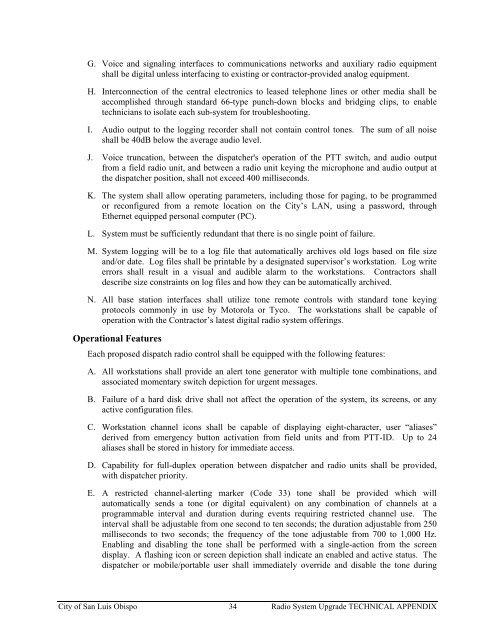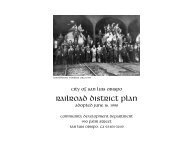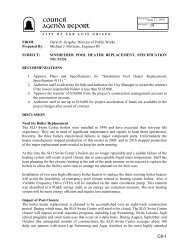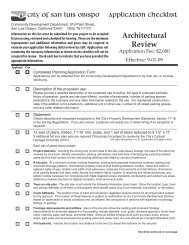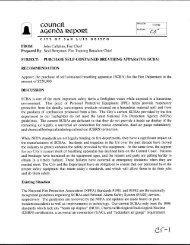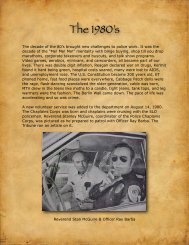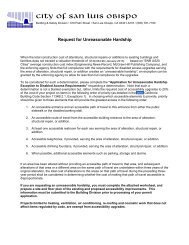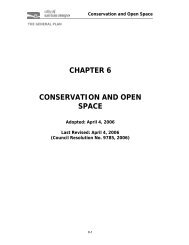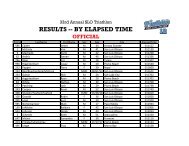Technical Appendix Specifications for the RADIO SYSTEM UPGRADE
Technical Appendix Specifications for the RADIO SYSTEM UPGRADE
Technical Appendix Specifications for the RADIO SYSTEM UPGRADE
You also want an ePaper? Increase the reach of your titles
YUMPU automatically turns print PDFs into web optimized ePapers that Google loves.
G. Voice and signaling interfaces to communications networks and auxiliary radio equipmentshall be digital unless interfacing to existing or contractor-provided analog equipment.H. Interconnection of <strong>the</strong> central electronics to leased telephone lines or o<strong>the</strong>r media shall beaccomplished through standard 66-type punch-down blocks and bridging clips, to enabletechnicians to isolate each sub-system <strong>for</strong> troubleshooting.I. Audio output to <strong>the</strong> logging recorder shall not contain control tones. The sum of all noiseshall be 40dB below <strong>the</strong> average audio level.J. Voice truncation, between <strong>the</strong> dispatcher's operation of <strong>the</strong> PTT switch, and audio outputfrom a field radio unit, and between a radio unit keying <strong>the</strong> microphone and audio output at<strong>the</strong> dispatcher position, shall not exceed 400 milliseconds.K. The system shall allow operating parameters, including those <strong>for</strong> paging, to be programmedor reconfigured from a remote location on <strong>the</strong> City’s LAN, using a password, throughE<strong>the</strong>rnet equipped personal computer (PC).L. System must be sufficiently redundant that <strong>the</strong>re is no single point of failure.M. System logging will be to a log file that automatically archives old logs based on file sizeand/or date. Log files shall be printable by a designated supervisor’s workstation. Log writeerrors shall result in a visual and audible alarm to <strong>the</strong> workstations. Contractors shalldescribe size constraints on log files and how <strong>the</strong>y can be automatically archived.N. All base station interfaces shall utilize tone remote controls with standard tone keyingprotocols commonly in use by Motorola or Tyco. The workstations shall be capable ofoperation with <strong>the</strong> Contractor’s latest digital radio system offerings.Operational FeaturesEach proposed dispatch radio control shall be equipped with <strong>the</strong> following features:A. All workstations shall provide an alert tone generator with multiple tone combinations, andassociated momentary switch depiction <strong>for</strong> urgent messages.B. Failure of a hard disk drive shall not affect <strong>the</strong> operation of <strong>the</strong> system, its screens, or anyactive configuration files.C. Workstation channel icons shall be capable of displaying eight-character, user “aliases”derived from emergency button activation from field units and from PTT-ID. Up to 24aliases shall be stored in history <strong>for</strong> immediate access.D. Capability <strong>for</strong> full-duplex operation between dispatcher and radio units shall be provided,with dispatcher priority.E. A restricted channel-alerting marker (Code 33) tone shall be provided which willautomatically sends a tone (or digital equivalent) on any combination of channels at aprogrammable interval and duration during events requiring restricted channel use. Theinterval shall be adjustable from one second to ten seconds; <strong>the</strong> duration adjustable from 250milliseconds to two seconds; <strong>the</strong> frequency of <strong>the</strong> tone adjustable from 700 to 1,000 Hz.Enabling and disabling <strong>the</strong> tone shall be per<strong>for</strong>med with a single-action from <strong>the</strong> screendisplay. A flashing icon or screen depiction shall indicate an enabled and active status. Thedispatcher or mobile/portable user shall immediately override and disable <strong>the</strong> tone duringCity of San Luis Obispo 34 Radio System Upgrade TECHNICAL APPENDIX


